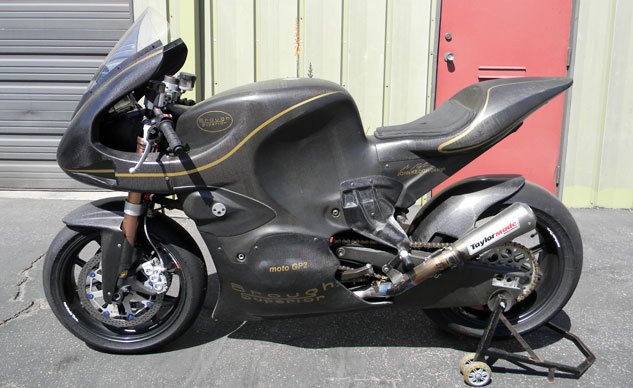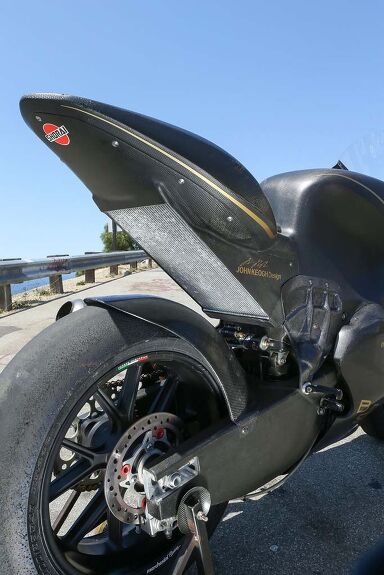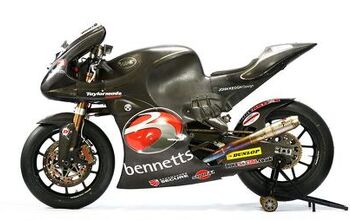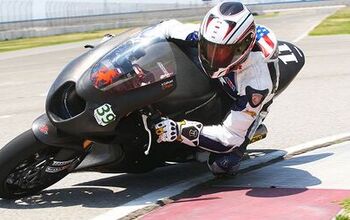Taylormade/Brough Superior Moto2 Racer

Two guys decide to take on the racing establishment
The introduction of the Moto2 class into the world championship in 2010 was met with mixed emotions. Moto2 spelled the end for the beloved 250cc two-strokes, but it also opened up a new world for engineering innovation. Based around a spec Honda CBR600RR engine, the essence of the class was to have brilliant minds develop a chassis around it to lap a racetrack the quickest. Instead of hunting for horsepower, emphasis would be placed on engineering excellence and rider talent to win races.
By most accounts, the series is a success. The racing is extremely close, Moto2 machines are faster than their 250cc two-stroke predecessors, and the past two champions, German Stefan Bradl and Spaniard Marc Marquez are acclimating well to MotoGP competition, especially Marquez.
However, dig beyond the surface and a trend is already starting to emerge. Bradl won his championship in 2011 aboard a Kalex chassis. His only real title contender that year was Marquez aboard a Suter chassis. Between them, they won 12 of the 18 races that year. The following year, with Bradl graduating to MotoGP, Marquez made the rest of the field look like amateurs while he piloted his Suter to the 2012 title.
That kind of dominance convinced much of the competition that either a Suter or Kalex chassis was the one to be aboard, effectively killing the notion of chassis development from several different fronts. At the 2013 season opener in Qatar, more than half of the field was made up of one of these two chassis. As of this writing, after 17 of 18 races this year, a Suter or Kalex has won every single Moto2 race.
Taking On The World
Paul Taylor and his business partner, designer John Keogh, also saw Moto2 as an open playing field they believe suited their particular strengths. Taylor, the name behind LA-based exhaust manufacturer Taylormade Racing, has long been a tinkerer, fabricator and motorcycle enthusiast. Keogh, meanwhile, has a design and engineering background, having previously worked at both Triumph and Buell. Neither had any interest in designing a new engine, so the spec Honda unit opened their creative floodgates to create a chassis around it. And hence the Taylormade Moto2 project was born.
Some may consider it ludicrous for two guys in a small shop in Los Angeles to challenge the might of two established chassis builders in Suter and Kalex, but that doesn’t deter either man. They just want to bring creative thinking back into motorcycle racing.
“We looked at the fundamental design of a motorcycle, from first principles to every single component of the bike,” Keogh says. “From here we tried to seek out where we could gain an advantage.”
From this intense inspection of the racing motorcycle, Taylor and Keogh came to the conclusion that a motorcycle is not very aerodynamic. “So our goal was to go for the smallest cross-section of area possible, not the most slippery shape. The monocoque allows us to do that, because it’s only as wide as the engine.”
Weight is also the enemy, so a focus on lightness emerged. Next they wanted a racing motorcycle with 50/50 weight distribution with rider onboard. And as you can imagine, the flood of ideas started to snowball, one on top of the other. The result is what you see here.
To understand the Taylormade Moto2 racer, we’ll start at the center and work our way outward. First, look at the bike as a whole. It’s by no means a beauty queen. As a designer, it pains Keogh that this bike might win the ugly duckling award, but he says he’s willing to forego the aesthetics because “functionality is the main priority. Whether we succeed or fail is determined on the stopwatch.”
The best place to start with the Taylormade Moto2 is the carbon fiber monocoque chassis, which uses the CBR600RR engine as a stressed member and meets the goals of being lightweight and extremely strong. As a general rule, Taylor said, each component of the motorcycle would have to perform at least two functions, preferably more. Maintaining the narrow-first mentality, Taylor likes to say the engine is “shrink wrapped” by the bodywork, and I can confirm this tight packaging as I was barely able to slip a finger between the fairing and the engine case.
The term monocoque, when referring to a motorcycle chassis, is a trendy phrase these days, made popular lately by Ducati, first in its grand prix motorcycles, and later in the 1199 and 899 Panigale models. However, according to Keogh, these aren’t true monocoques.
“On the Ducati grand prix bikes, the airbox was also a structural member, the old John Player Norton that raced in the TT was called monocoque but the bodywork came off, and Kort Ballington’s [KR500] Kawasaki from the early ’80s, again the tank came off. So by definition these aren’t monocoques. Even the Britten wasn’t completely a monocoque,” Keogh says.
“This bike [Taylormade Moto2] is simple and has very few pieces,” Taylor continues. “Just the monocoque, swingarm, two pieces of bodywork (nose and tail piece), front forks, radiator, then the engine.” If maintenance work is required on the engine, they’ll actually support the engine, then pull the entire monocoque off the top.
A distinctive feature of the Taylormade Moto2 is the rear-mounted radiator. Moving it to the back meant the engine could be mounted 50mm forward, which then helped with the 50/50 weight distribution they were after. Another benefit of radiator relocation was fresh air not being obstructed by the front wheel, meaning it was possible to use a smaller radiator. A fresh charge of cool air enters through the giant duct that takes up almost the entire nose of the bike (it swallowed my entire open hand).
Taylor and Keogh designed the monocoque to allow that duct to continue, above the engine, through the fuel tank, and all the way to the rear-mounted radiator. The fuel tank is mounted vertically, behind the engine, to keep the center of gravity consistent as the fuel load runs down. There’s essentially a hole running through it to allow cool air from the front to reach the back. “That’s why we used the monocoque chassis, to integrate the chassis and fuel tunnel,” says Taylor. “We didn’t use carbon just to use carbon, we used carbon because it enabled us to build a monocoque chassis, which is the best use of the structural material.”
Funny Front Ends
Moving to the front of the motorcycle, beyond the slim nose and wide mouth, you might notice a funny looking, unconventional front suspension design. For years now, huge companies like Ohlins and Showa have perfected the conventional fork, while others have come and gone with weird, though maybe theoretically better, designs. “Funny front ends fail because you try and compete with Ohlins,” Keogh noted. “We’re never going to be able to compete with Ohlins, so we try and look for advantages elsewhere.”
One of the main disadvantages of a conventional fork setup is stiction – when the fork tube does not compress and release in one fluid motion. This is especially true at extreme lean angles. Taylor and Keogh felt they could gain their advantage by separating the braking and suspension forces, incorporating a BMW Telelever-style front end with an A-arm mounted to a carbon composite structure attached to the CBR’s cylinder head. An inverted fork measuring 43mm is used, with Traxxion Dynamics gas cartridges inside, “so tuning of the fork is very conventional.” The difference between Taylormade and BMW, however, was making the front feel as close as possible to a conventional fork.
Taylor says this bike will still dive when braking, just not as much. “The A-arm mitigates the weight transfer, but we designed it so the braking forces still compress the fork slightly. We then run 25% lighter fork springs because braking forces have been reduced drastically, and this provides the feel most riders are used to at the front.” Just how soft are the springs? A one-finger tug on the bar raised the bike a solid half inch or so before gravity quickly brought it back down to its static position.
A-arm pivot angle, which tunes the dive resistance, is also adjustable. Taylor notes how test and development rider, Shawn Higbee, has been “very demanding” when it comes to the feel of the bike. In regards to the A-arm pivot angle, “we had reached the limits of adjustability and Shawn wanted more, so we had to graft a plate into the chassis to accommodate his wishes.”
When you have an unconventional front end, you can expect unconventional geometry numbers. Taylor says rake is set at a steep 16 degrees (a Yamaha R6 is 24 degrees for comparison). “We did this because we feel a lot of rake angle in conventional forks is to allow them to work without stiction. Our forks are well supported in the center with the wishbone, so that allows us a steep [rake] angle.”
Trail is adjusted via an insert in the top triple clamp. Taylor continues, “We can change trail anywhere from 85mm-115mm. Right now it’s about 105mm (4.1 inches), which is conventionally a lot (R6 trail is 3.8 inches). But that’s what Shawn says gives him the feel and steering he likes.”
Rear suspension is more conventional, with a Penske shock handling bump control in the back. The swingarm, too, is completely carbon composite. During early testing, Higbee was experiencing violent chatter that wouldn’t improve no matter what was changed.
“What we found was the swingarm was twisting torsionally,” says Taylor, “but it was being reflected in front end chatter.” Taylor and his team then built stress test rigs to test components under load, paying particular attention to deflection. The current swingarm, the one Higbee is happy with, is the fifth iteration of the original design. “It’s a completely different shape than the first swingarm. We made it deep to give a large cross-section so the load at the axle is spread out over the whole area.”
When modifying the original swingarm to dial out the twist, Taylor simply added more and more carbon until the desired stiffness was reached, “but that’s not taking advantage of the material,” he says, noting adding more material also adds unnecessary weight. “What you want to do is spread the load over a large area of fibers, and you do that with shape. That’s why there’s such a large drop on the underside of the swingarm.” Once the torsional stiffness was where they wanted it, a new swingarm was made, using the minimum amount of carbon fiber necessary, to take advantage of carbon’s strength and lightness.
Of course, working with carbon fiber isn’t cheap or easy. After all, these are just two guys working out of a small shop.
“We had to develop techniques within our resources to achieve the results we’re looking for. And we’ve done that,” Taylor says. “We have a collaborator in England, John McQuilliam, who is the Chief Designer on the Marussia F1 team. His main responsibility is making the tub for the F1 car. He advises us on affordable testing techniques and he’s particularly good at showing us practical ways to test and get a very fit-for-purpose result.” McQuilliam’s help came especially handy when testing swingarms.
When all is said and done, Taylor says the bike weighs 315 pounds, ready to ride. Moto2 rules mandate bike and rider together must weigh at least 474 pounds, and considering the tiny statures of most of the riders on the grid, “we’ll more than likely have to ballast it to make the minimum weight.”
Brough Superior
As Keogh alluded to earlier, the stopwatch doesn’t lie. The next step for the team is proving their concept in the crucible of top-level racing. “I don’t think you can describe the current Moto2 bikes as flawed since the racetrack is the ultimate proving ground. Now, we need to get it on the grid to prove the concept is correct.”
To do that, however, the team is looking for sponsorship and the right rider, particularly a rising American star. “What we’re looking for is a rider with an open mind,” says Taylor. “Someone willing to explore the capabilities of the bike, particularly under braking, because this is not like a conventional motorcycle.”
To help with the sponsorship money, Taylormade has teamed up with an iconic brand looking to make a comeback: Brough Superior. It may seem a strange collaboration at first, but the two actually have a closer connection than one might think.
“The Brough heritage is racing,” Taylor says. “Mark Upham, the new owner of Brough, is keen to collaborate with a racing project to bring the Brough Superior brand to the racetrack as part of bringing the whole name back to life. In fact, Brough will be unveiling a new road bike at EICMA this year.”
As strange as this partnership might initially seem, the two parties share similar goals. Both Taylor and Upham want to bring their respective dreams to life. For Brough, recognition at the racetrack will hopefully lead to future road bike sales. For Taylor, he’s hoping the recognizable name will help attract further sponsors for the effort.
In addition to the sponsor attraction, Brough provides Taylormade a European base should this project be successful. “This is a way we can still be based here in California and still make inroads to the Spanish-dominated world of grand prix racing,” says Keogh, who splits his time between L.A. and the U.K. Neither Taylor nor Brough had any technical say in the other’s current projects, but Taylor says the two are planning to continue their relationship for “future street-related products.”
Looking Toward The Future
It’s a bit premature to be thinking about grand prix glory, but Paul Taylor has built successful motorcycles before. In 1995, his Saxon/Triumph won races in the international BEARS championship, even beating the famed Britten at Monza. Right now, the team is looking to further refine the bike while securing the right rider and sponsorship program for a wildcard entry at the 2014 Grand Prix of the Americas in Austin, Texas.
Assuming this project is successful Taylor says it would be dream come true but admits “We’re not a racing team.” One of the goals for the project is to hopefully show its potential.
“From there an existing race team would campaign the bike and we’d [Taylormade] be the factory behind the bike to develop it and make future models.”
However, Taylor and Keogh have more long-range visions for this project beyond racing. The two want to change the transportation industry in general.
“I think the future for transportation is to provide more efficient vehicles,” Taylor says, noting the practical applications for composite materials. “What we’re working on is making fabrication more cost effective through different techniques and materials and taking the knowledge we’ve learned from racing and applying it to transportation projects, where light weight will provide better efficiency.”
Taylor and Keogh have always dreamt big, and racing is about as high a target one can reach for. The two understand the effects racing can have in improving the breed, and ultimately it’s the most demanding proving ground for products the general consumer will enjoy in the future. The Moto2 bike could become the realization of racing success for the pair, and if that’s true, then the big winner is us, as trickle-down racing technology finds its way to benefit the masses.

Troy's been riding motorcycles and writing about them since 2006, getting his start at Rider Magazine. From there, he moved to Sport Rider Magazine before finally landing at Motorcycle.com in 2011. A lifelong gearhead who didn't fully immerse himself in motorcycles until his teenage years, Troy's interests have always been in technology, performance, and going fast. Naturally, racing was the perfect avenue to combine all three. Troy has been racing nearly as long as he's been riding and has competed at the AMA national level. He's also won multiple club races throughout the country, culminating in a Utah Sport Bike Association championship in 2011. He has been invited as a guest instructor for the Yamaha Champions Riding School, and when he's not out riding, he's either wrenching on bikes or watching MotoGP.
More by Troy Siahaan


















































Comments
Join the conversation
A cool blue sky exercise, but too many departures from the proven, they will probably be chasing their tails forever trying to get this thing handling right. At this level, tiny changes make a huge difference. Huge departures from the proven will be tough to make work. Wish them the best though, always interesting to see new ideas.